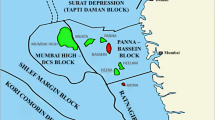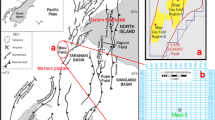Abstract
This study integrated three-dimensional (3D) structural and petrophysical models to establish the reservoir characteristics of the Mangahewa Formation within the Pohokura Gas-Condensate Field. The 3D structural model, in which 3 horizons and 51 faults were interpreted, was developed using an algorithm for volume-based modeling. The complex structural mechanism was observed as compressional and extensional stresses resulting in steeply dipping normal and reverse faults. The fault throw was estimated to be up to 85 m, and 33% of the faults had throws of less than 10 m. This explains the fault growth system as small, younger faults have merged to develop larger faults. Well log analysis was used to evaluate important petrophysical parameters such as effective porosity, net-to-gross ratio, shale volume, and water and hydrocarbon saturation. After applying a cutoff, the estimated values for effective porosity, net-to-gross ratio, shale volume, and water and hydrocarbon saturation were 12–18%, 13–31%, 13–26%, 6–22%, and 78–94%, respectively. The estimated values were then incorporated into the grid cells to design 3D petrophysical modeling using the algorithm for sequential Gaussian simulation. The structural model indicated effective trapping and the presence of a conduit mechanism for hydrocarbons. The well log analysis identified significant effective porosities containing substantial hydrocarbon saturation, whereas the petrophysical models showed very good dissemination of the petrophysical parameters. From these models, which also incorporate the gas–water contact, proposed drilling sites for future exploration and well development were proposed. The results characterize the Mangahewa Formation as a good reservoir within the Pohokura Gas-Condensate Field.


















Similar content being viewed by others
References
Adelu, A. O., Aderemi, A. A., Akanij, A. O., Sanuaded, O. A., Kakad, S. I., Afolabi, A., et al. (2019). Application of 3D static modeling for optimal reservoir characterization. Journal of African Earth Sciences, 152, 184–196.
AlHakeem, A. (2018). 3D seismic attribute analysis and machine learning for reservoir characterization in Taranaki Basin, New Zealand. Doctoral Dissertation 2659. Missouri University of Science and Technology.
Ali, M., Abdelhady, A., Abdelmaksoud, A., Darwish, M., & Essa, M. A. (2020). 3D static modeling and petrographic aspects of the Albian/Cenomanian Reservoir Komombo Basin, Upper Egypt. Natural Resources Research, 29, 1259–1281.
Alotaby, W. D. (2015). Fault interpretation and reservoir characterization of the farewell formation within Kerry field, Taranaki Basin, New Zealand. Masters Theses 7458. Missouri University of Science and Technology.
Aydin, A. (2000). Fractures, faults and hydrocarbon entrapment, migration and flow. Marine and Petroleum Geology, 17, 797–814.
Brown, A. (2003). Capillary effects on fault-fill sealing. AAPG Bulletin, 87(3), 381–395.
Campbell, H. J., Malhoff, A., Browne, G., Graham, I., & Sutherland, R. (2012). New Zealand geology. Episodes, 35(1), 57–71.
Dong, S. P., Shalaby, M. R., & Islam, M. A. (2018). Integrated reservoir characterization study of the McKee Formation, Onshore Taranaki Basin, New Zealand. Geosciences, 8, 105.
El-Din, E. S., Mesbah, M. A., Kassab, M. A., Mohammed, I. F., & Cheadle, B. A. (2013). Assessment of petrophysical parameters of clastics using well logs: The Upper Miocene in El-Wastani gas field, onshore Nile Delta, Egypt. Petroleum Exploration and Development, 40(4), 488–494.
Emujakporue, G. O. (2017). Petrophysical properties distribution modelling of an onshore field, Niger Delta, Nigeria. Current Research in Geoscience, 7(1), 14–24.
Franzel, M., & Back, S. (2019). Three-dimensional seismic sedimentology and stratigraphic architecture of prograding clinforms, central Taranaki Basin, New Zealand. International Journal of Earth Sciences, 108, 475–496.
Giba, M., Nicol, A., & Walsh, J. J. (2010). Evolution of faulting and volcanism in a back-arc basin and its implication for subduction processes. Tectonics, 29(4), 1–18.
Griffin, A. G., Bland, K. J., Field, B., Strogen, D. P., Crutchley, G., Lawrence, M. J., et al. (2015). Reservoir characterization of East Coast and Pegasus Basin, Eastern North Island, New Zealand. In International conference and exhibition, Melbourne, Australia, 13–16 September 2015, p. 150 https://doi.org/10.1190/ice2015-2207834
Hakimi, M. H., Al-Qadasi, B. A., Al-Sharrabi, Y., Al-Sorore, O. T., & AlSamet, N. G. (2017). Petrophysical properties of Cretaceous clastic rocks (Qishn Formation) in the Sharyoof oilfield, onshore Masila Basin, Yemen. Egyptian Journal of Petroleum, 26(2), 439–455.
Haque, A. K. M. E., Islam, M. A., & Shalaby, M. R. (2016). Structural modeling of the Maui Gas Field, Taranaki Basin, New Zealand. Petroleum Exploration Development, 43(6), 883–892.
Haque, A. K. M. E., Islam, M. A., Shalaby, M. R., & Sadeque, J. (2018). Integrated 3D facies modeling of the Mangahewa Formation, Maui Gas Field, Taranaki Basin, New Zealand. Journal of Petroleum Exploration and Production Technology, 8, 1017–1049.
Higgs, K. E., Crouch, E. M., & Raine, J. I. (2017). An interdisciplinary approach to reservoir characterization: An example from the early to middle Eocene Kaimiro Formation, Taranaki Basin, New Zealand. Marine and Petroleum Geology, 86, 111–139.
Higgs, K. E., King, P. R., Raine, J. I., Sykes, R., Browne, G. H., Crouch, E. M., et al. (2012). Sequence stratigraphy and controls on reservoir sandstone distribution in an Eocene marginal marine-coastal plain fairway, Taranaki Basin, New Zealand. Marine and Petroleum Geology, 32, 110–137.
Ilg, B. R., Samuel, H. S., Nicol, A., Baur, J., Fohrmann, M., Funnell, R., et al. (2012). Normal faults and gas migration in an active plate boundary, southern Taranaki Basin, offshore New Zealand. AAPG Bulletin, 96, 1733–1756.
Infante-Paez, L., & Marfurt, K. J. (2017). Seismic expression and geomorphology of igneous bodies: A Taranaki Basin, New Zealand, case study. Interpretation, 5(3), SK121–SK140. https://doi.org/10.1190/INT-2016-0244.1.
Johnston, D. (2004). Reservoir characterization improves stimulation, completion practices. Oil Gas Journal, 102(4), 60–63.
Jumat, N., Shalaby, M. R., Haque, A. K. M. E., Islam, M. A., & Hoon, L. L. (2018a). Geochemical characteristics, depositional environment and hydrocarbon generation modeling of the upper Cretaceous Pakawau Group in Taranaki Basin, New Zealand. Journal of Petroleum Science and Engineering, 163, 320–339.
Jumat, N., Shalaby, M. R., & Islam, M. A. (2018b). Integrated reservoir characterization of the Paleocene Farewell Formation, Taranaki Basin, New Zealand, using petrophysical and petrographical analyses. Journal of Petroleum Exploration and Production Technology, 8, 685–701.
Kalid, N. Z. A., & Hamzah, U. (2014). Sequence stratigraphy of the Miocene, Pohokura Field, Taranaki Basin, New Zealand. In AIP conference proceedings, Vol. 164, No. 1, pp. 637–643.
King, P. R., & Thrasher, G. P. (1996). Cretaceous Cenozoic geology and petroleum systems of the Taranaki Basin, New Zealand. In Institute of geological and nuclear sciences monograph, Vol. 13, No. 2. Institute of Geological & Nuclear Sciences, Lower Hutt.
Knox, G. J. (1982). Taranaki Basin, structural style and tectonic setting. New Zealand Journal of Geology and Geophysics, 25, 125–140.
Kutovaya, A., Kroeger, K. F., Seebeck, H., & Back, S. (2019). Thermal effects of magnetism on surrounding sediments and petroleum systems in the Northern Offshore Taranaki Basin, New Zealand. Geosciences, 9, 288.
Ma, Y. Z., & Pointe, P. L. (2011). Uncertainty analysis and reservoir modeling: Developing and managing assets in an uncertain world. In Y. Z. Ma & P. L. Pointe (Eds.), American Association of Petroleum Geologists, Memoirs (Vol. 96).
Mennan, A. (2017). Well log interpretation and 3D property modeling of Maui-B Field, Taranaki Basin, New Zealand, Master Theses, 7722. Missouri University of Science and Technology.
Nabawy, B. S. (2020) Discussion on the influence of structures on drainage patterns in Tushka region, SW Egypt. Journal of African Earth Science, 136, 262–271" by C.A. Robinson, H. El-Kaliouby, E. Ghoneim. https://doi.org/10.1016/j.jafrearsci.2019.103640
New Zealand Petroleum Basins. (2014). Report by ministry of business innovation and employment, New Zealand. https://www.nzpam.govt.nz/assets/Uploads/doing-business/nz-petroleum-basins-part-one.pdf; https://www.nzpam.govt.nz/assets/Uploads/doing-business/nz-petroleum-basins-part-two.pdf.
Osinowo, O. O., Ayorinde, J. O., Nwankwo, C. P., Ekeng, O. M., & Taiwo, O. B. (2018). Reservoir description and characterization of Eni field offshore Niger Delta, southern Nigeria. Journal of Petroleum Exploration and Production Technology, 8(2), 381–397.
Palmer, J. (1985). Pre-Miocene lithostratigraphy of Taranaki Basin, New Zealand. New Zealand Journal of Geology and Geophysics, 28(2), 197–216.
Pilaar, W. F. H., & Wakefield, L. L. (1984). Hydrocarbon generation in the Taranaki Basin, New Zealand. In G. Demaison & R. J. Murris (Eds.), Petroleum Geochemistry and Basin Evaluation. American Association of Petroleum Geologists, Memoirs (Vol. 35, pp. 405–423).
Prieto, A. M., & Archer, R. (2015). Rock typing in geothermal reservoirs of New Zealand. In SPWLA 56th annual logging symposium, July 18–22, 2015. SPWLA-2015-RR. https://doi.org/10.13140/RG.2.1.1.167.5368
Qadri, S. M. T., Islam, M. A., & Shalaby, M. R. (2019a). Application of well log analysis to estimate the petrophysical parameters and evaluate the reservoir quality of the Lower Goru Formation, Lower Indus Basin, Pakistan. Geo-mechanics and Geophysics for Geo-energy and Geo-resources, 5, 271–288.
Qadri, S. M. T., Islam, M. A., & Shalaby, M. R. (2019b). Three Dimensional petrophysical structural and volumetric analysis to model the reservoir potential of the Kupe Field, Taranaki Basin, New Zealand. Natural Resources Research, 28, 369–392.
Qadri, S. M. T., Islam, M. A., Shalaby, M. R., & Haque, A. K. M. E. (2017). Seismic interpretation and structural modelling of Kupe Field, Taranaki Basin, New Zealand. Arabian Journal of Geosciences, 10, 295.
Qadri, S. M. T., Shalaby, M. R., Islam, M. A., & Hoon, L. L. (2016). Source Rock Characterization and hydrocarbon generation structural of the middle to Late Eocene Mangahewa Formation in Taranaki Basin, New Zealand. Arabian Journal of Geosciences, 9, 559.
Reilly, C., Nicol, A., Walsh, J. J., & Seebeck, H. (2015). Evolution of faulting and plate boundary deformation in the southern Taranaki Basin, New Zealand. Tectonophysics, 651, 1–18.
Roncaglia, L., Arnot, M., Baur, J., Forhmann, M., King, P., Kroeger, K. F., et al. (2010). Integrated workflow for modeling basin-scale petroleum systems: Applications to the Kupe Area, Taranaki, New Zealand. SPE. https://doi.org/10.2118/133903-MS.
Roncaglia, L., Forhmann, M., Milner, M., Morgans, H. E. G., & Crundwell, M. P. (2013). Well log stratigraphy in the central and southern offshore area of the Taranaki Basin, New Zealand. GNS Sciences Report, 2013/27, 26p + enclosures.
Sarma, M., Kellet, R., Pryde, S., & Reynolds, G. (2014). Petroleum systems structural: Charge evaluation of the Eltham area (PEP 51150) (p. 6). Wellington: Onshore Taranaki Basin: New Zealand Corp.
Seyyedattar, M., Zendehbiudi, S., & Butt, S. (2020). Technical and non-technical challenges of development of offshore petroleum reservoirs: Characterization and production. Natural Resources Research, 29, 2147–2189.
Souche, L., Lepage, F., & Iskenova, G. (2013). Volume based modeling-automated construction of complex structural models. In 75th EAGE conference and exhibition incorporating SPE EUROPEC. London-UK, 10–13th June 2013.
Yu, X. Y., Ma, Y. Z., Psaila, D., Pointe, P. L., Gomez, E., & Li, S. (2011). Reservoir characterization and modeling. In Y. Z. Ma & P. LaPointe (Eds.), Uncertainty analysis and reservoir modeling. A look back to see forward. AAPG Memoir (Vol. 96, pp. 289–309).
Author information
Authors and Affiliations
Corresponding author
Rights and permissions
About this article
Cite this article
Islam, M.A., Yunsi, M., Qadri, S.M.T. et al. Three-Dimensional Structural and Petrophysical Modeling for Reservoir Characterization of the Mangahewa Formation, Pohokura Gas-Condensate Field, Taranaki Basin, New Zealand. Nat Resour Res 30, 371–394 (2021). https://doi.org/10.1007/s11053-020-09744-x
Received:
Accepted:
Published:
Issue Date:
DOI: https://doi.org/10.1007/s11053-020-09744-x




